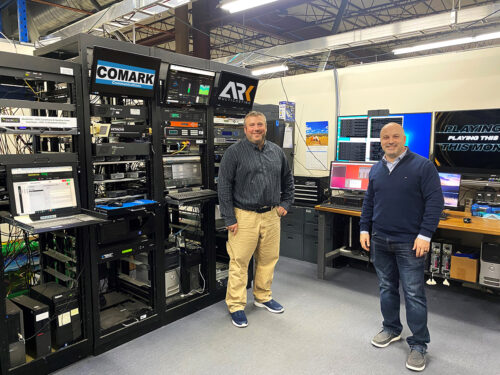ARK Multicasting demos last mile edge caching with ATSC 3.0
Tuesday, October 6th, 2020
ARK Multicasting, Inc. Pilots Last Mile Edge Caching Through ATSC 3.0
DALLAS — ARK Multicasting, Inc. (“ARK”) today announced the successful pilot of their last mile edge caching technology over the Next Gen TV standard of ATSC 3.0.
The demo showed ARK caching 4K, HD, and SD video files on a consumer edge device for video on demand. The files were transmitted from a Low Power TV (“LPTV”) broadcast over-the-air environment and included the caching of PDF’s, Microsoft Word documents, Keynote and PowerPoint files as well.

The consumer edge caching took place simultaneously with live linear television seen on a Sony ATSC 3.0 television separate from the caching device.
The files originated at ARK headquarters in Dallas, TX and were sent via FTP to the transmission head-end in Southwick, MA in partnership with Hitachi-Comark and their Comark Digital Services (CDS) integration team.
ARK CEO, Joshua Weiss said, “This goes a long way in proving how ARK is the solution to the current congested networks across America, and the underserved who lack broadband. We are now able to move the most popular videos, software and gaming updates, and other data files all the way to the end user’s home making the home part of the larger cloud.”
The demonstration also validates several of the planned use cases for the new ATSC 3.0 television standard which turns traditional television stations into datacasting facilities with the benefit of one-to-many IP multicasting in ARK’s use case.
President of ATSC, Madeleine Noland said, “It’s very exciting to see new and innovative implementations of ATSC 3.0 come to life. Edge caching content in the home can serve a wide variety of purposes from relieving congestion on two-way IP networks to providing needed connectivity to rural or under-served populations. For example, classroom content could be pre-loaded in students’ homes so that bandwidth isn’t an issue during remote classes, and I can envision many other applications of this feature of ATSC 3.0. Kudos to ARK and Comark for their collaboration on this important use case.”
Weiss continued, “By shifting the traditional ‘edge’ all the way to the consumer home, we relieve last mile congestion and enhance the user experience. Localized data caching means less buffering, faster downloads, and better overall broadband. This is just the next step in ARK showing all the ways our one-to-many IP pipe can be utilized.”
Latest News
- Tata Motors selects HARMAN Automotive's in-vehicle app store
- Media Distillery to power Swisscom ad-free replay product
- MagentaTV strengthens addressable TV business with Equativ
- Deutsche Telekom selects Broadpeak Cloud DVR solution for MagentaTV
- Nexxen empowers Australian advertisers using VIDAA ACR data
- TargetVideo integrates AI for video content categorization